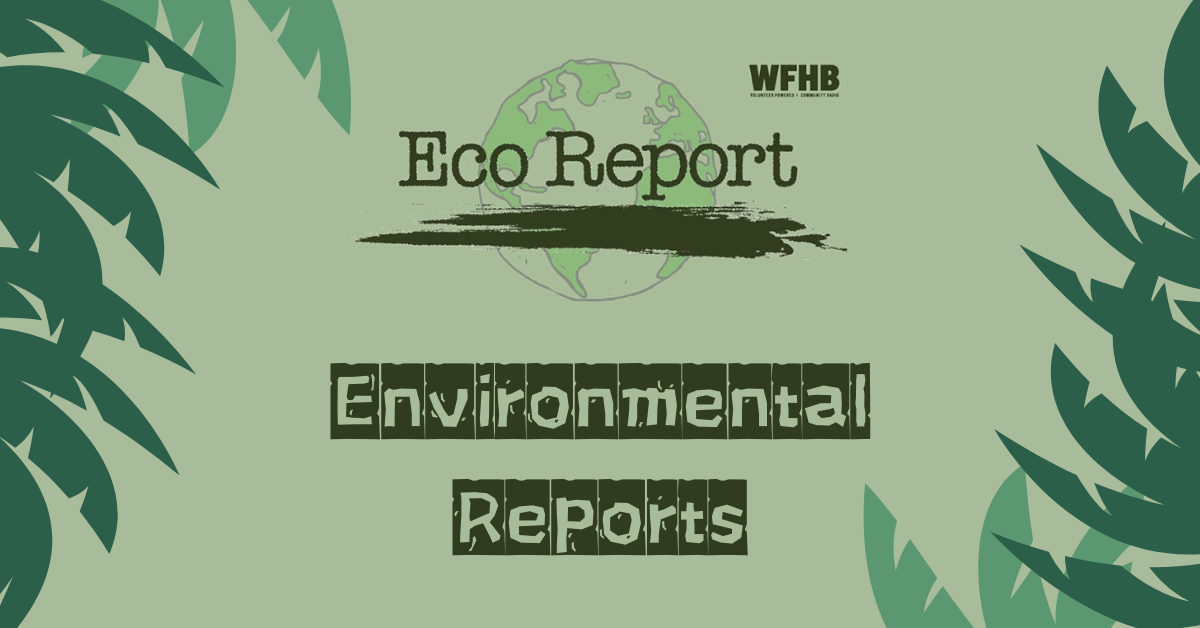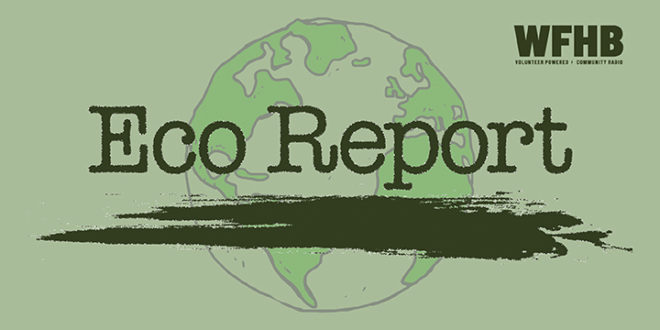Podcast: Play in new window | Download (70.9MB)
Subscribe: RSS
In this week’s Eco Report feature, part two of ‘Local Food Sovereignty Amidst Global Challenges’ from Eco Report EXTRA – our online sister show. The full program won Third Place for Best Radio Documentary Special of 2023 at the Society of Professional Journalists Awards in April.

While the Indiana Legislature and the power companies are doing all they can to kill solar, other regions of the country are seeing benefits to solar. One of those unexpected places is the New England states because they don’t have much sun in the winter. But the expansion of rooftop solar in New England is keeping the lights on during winter, surprising the region’s grid operator and challenging long-standing assumptions that the growth of renewable energy could destabilize the power system.
Officials at ISO New England, which oversees the six-state power market, concluded after months of research that the region’s power grid has been strengthened by cold-weather sunlight, an unanticipated finding that adds fuel to a growing debate over the impact that renewable energy has on the nation’s labyrinth of power plants and transmission lines. The findings stand to alter regulators’ view of rooftop solar, which many had seen as a small and unpredictable source of energy.
The influx of solar has paved the way for the retirement of one of New England’s dirtiest power plants. Mystic Generating Station, the third-largest power plant in the region, is slated to close next summer. New England electric customers have been paying a subsidy in recent years to keep the 1,413 megawatt gas plant from shutting down. The subsidy was approved by the Federal Energy Regulatory Commission in 2018 at the request of ISO New England, which at the time said the plant was needed to shore up the region’s electric grid. But when the grid operator testified at a FERC meeting in Maine last week, it said Mystic isn’t needed to prevent blackouts across the region. Rooftop solar is one reason why.
New England relies on natural gas for about half of its power generation. That can be a problem in winter, when much of the region’s limited pipeline capacity is dedicated to natural gas for heating homes and other buildings. That led New England to turn to oil as a backup source of power generation. Many gas plants in the region have installed large oil tanks that can be tapped when gas prices spike, but oil’s highcarbon content contributes to climate change. Rooftop solar conserves the region’s oil supplies. ISO New England estimates that every 700 MW of solar capacity reduces oil consumption by 7 to 10 million gallons or gas demand by 1 to 1.5 billion cubic feet. The grid operator said it had around 5,400 MW of solar online at the end of last year. The vast majority of that is on rooftops.
Reuters reports that giant blue-grey sei whales that vanished from Argentina’s Patagonian coast a century ago due to hunting are starting to flourish once again, demonstrating how species can recover when measures to protect them are put in place. In the 1920s and 1930s regular whaling ships along the shores of Argentina, and beyond, saw populations dwindle. In the last 50 years, global bans on commercial whaling have helped populations of sei and others revive.
“They disappeared because they were hunted, they did not become extinct but were so reduced that no one saw them,” said Mariano Coscarella, biologist and researcher in marine ecosystems at the Argentine state science body. Coscarella added that it had taken decades for numbers to recover enough that the whales had again been sighted, which only started to happen again in recent years. “In this case it took over 80 years,” Coscarella said. “They breed every 2 or 3 years and so it took almost 100 years for them to have appreciable numbers for people to realize they were there.”
The team last month worked to fit some sei whales with satellite trackers to map their migration patterns, with funding from the National Geographic’s Pristine Seas project. They recorded footage of them from boats, drones and below water. “We can consider this a success of conservation on a global scale,” Coscarella said, adding that the global moratorium on whaling was critical to numbers improving. He warned that countries pulling out of this agreement would jeopardize the recovery.
The success with sei whales is consistent with the viability of the right whale population in the Southern Hemisphere. The right whale population is about 3,500 animals. The right whale population in the Northern Hemisphere is only about 350 animals. The northern right whale may be extinct by 2100.
The Office of Resilience and Coastal Protection says that mangroves are one of Florida’s true natives. They thrive in salty environments because they can obtain freshwater from saltwater. Some secrete excess salt through their leaves, while others block absorption of salt at their roots. Mangroves are important in limiting coastal erosion during hurricanes. Florida’s estimated 600,000 acres of mangrove forests contribute to the overall health of the state’s southern coastal zone and beyond. This ecosystem traps and cycles various organic materials, chemical elements and important nutrients.
Mangrove roots act not only as physical traps but provide attachment surfaces for various marine organisms. Many of these attached organisms filter water through their bodies and, in turn, trap and cycle nutrients. The relationship between mangroves and their associated marine life cannot be overemphasized.Mangroves provide protected nursery areas for fishes, crustaceans and shellfish. They also provide food for a multitude of marine species such as snook, snapper, tarpon, jack, sheepshead, red drum, oyster and shrimp. Florida’s important recreational and commercial fisheries would drastically decline without healthy mangrove forests.
Many animals find shelter either in the roots or branches of mangroves. Mangrove branches are rookeries, or nesting areas, for beautiful coastal birds such as brown pelicans and roseate spoonbills.It is true that mangroves can be naturally damaged and destroyed, but there is no doubt that human impact has been most severe. Scientists in multiple agencies, including the Florida Wildlife Research Institute, Smithsonian Institute, Florida Department of Environmental Protection and many more are studying changes in Florida’s coastal habitats. The scientists evaluate habitat changes by analyzing aerial photographs from the 1940s and 1950s and satellite imagery and aerial photography from the 1980s.
Frequently the changes illustrate loss of mangrove acreage. Through researching the history of study sites, these losses are often attributed to human activities. However, mangroves are also gaining ground along their northern Florida habitat limits. As winter cold snaps decrease, mangroves are able to expand further north into new territory. Continued evaluation of aerial images between 1984 and 2011 has shown that the Florida Atlantic Coast gained more than 3,000 acres of mangroves. All the increase occurred north of Palm Beach County and the acreage between Cape Canaveral and St. Augustine doubled. Much of these gains come at the expense of salt marsh communities. Research is ongoing to determine the impacts, both positive and negative, of this transition.
There’s an update on the Florida Panthers from the Center for Biological Diversity. As few as 200 Florida panthers are left in the wild. On average nearly 30 are killed every year, mostly by vehicle strikes. And the threat will be even more dire if runaway development projects in Lee and Collier counties, the heart of panther habitat, go forward. The U.S. Fish and Wildlife Service says nearly double the number of panthers could be killed if these cats keep losing ground on the shrinking patch of habitat that still remains.
That would doom them to extinction. Decades of urban sprawl have left Florida panthers eking out a living in less than 5% of their historic range. Today they’re the only large felines living in the Southeast. By keeping roads and cars from slashing through their habitat — and securing the last few areas where they can still hunt and find mates — we can pull these great cats back from the brink.
Carbon dioxide is increasing in the atmosphere 10 times faster than it has in the last 50,000 years, according to a new study led by researchers from University of St. Andrews and Oregon State University. The findings shed light on periods of abrupt climate change in the planet’s history while offering new understanding of the impacts of today’s climate crisis. “Studying the past teaches us how today is different. The rate of CO2 change today really is unprecedented,” said Kathleen Wendt, lead author of the study and an Oregon State University assistant professor in the College of Earth, Ocean and Atmospheric Sciences, in a press release from University of St. Andrews. Our research identified the fastest rates of past natural CO2 rise ever observed, and the rate occurring today, largely driven by human emissions, is 10 times higher.
FEATURE REPORT

In this weeks feature, part two of an episode of Eco Report EXTRA (E.R.X.) – our online sister show. The full program won Third Place for Best Radio Documentary Special of 2023 at the Society of Professional Journalists Awards in April.

- Enjoy an Intro to Wild Edibles on Saturday, June 8th, from Noon to 2 pm at the RCA Community Park. You will explore the forest and meadows for wild, edible treasures. Bring a foraging bag. Sign up at bloomington.IN.gov/parks.
- Animals like to hide in interesting places. Join Naturalist Kaitlyn for a What’s Under That Rock hike at McCormick’s Creek State Park on Saturday, June 8th, from 2 to 3 pm. Hike down to the waterfall to see these hidden worlds. Meet at the Canyon Inn Lawn.
- Worried about invasive plants? Then plan to participate in an If You Can’t Beat ‘em, Eat ‘em! presentation at Brown County State Park on Sunday, June 9th, from 3 to 3:45 pm. You will learn about invasive species, how to identify them and how to cook and eat them. Many are edible. Take home a free recipe card to remember what you learned.
- Goose Pond Fish and Wildlife Area is hosting Wild Wednesdays in June, July and August. Enjoy short nature hikes outside the Goose Pond Visitors Center. Meet at 10 am and learn about Indiana’s wetlands, critters, and more. Bring water, sunscreen and bugspray. Come out this Wednesday, June 12th.
- Take a Tree ID Hike at Brown County State Park on Friday, June 14th, from 4 to 4:45 pm. Walk on the Discovery Trail to learn some traits of common Indiana trees and practice identifying them.
Credits:
On Air………………………………..Julianna Dailey
On Air……………………………….Cynthia Roberts
Headlines…………………………………Norm Holy
Feature Report…………………………….Zyro Roze
Script………………………………….Julianna Dailey
Events Calendar…………………….Julianna Dailey
Engineer……………………………Branden Blewett
Are you looking for a way to make a difference on environmental issues?
EcoReport is looking for reporters, engineers, and segment producer to report facts on how we’re all affected by global climate disruption and the ongoing assaults on our air, land and water. We also celebrate ecologists, tree huggers, soil builders and other champions who actively protect and restore our natural world, particularly those who are active in south central Indiana. All levels of experience and all ages are welcome, and we provide the training you’ll need. WFHB also offers internships. To volunteer for Eco Report, call at (812) 323-1200, or e-mail [email protected].
 WFHB Bloomington Community Radio
WFHB Bloomington Community Radio


